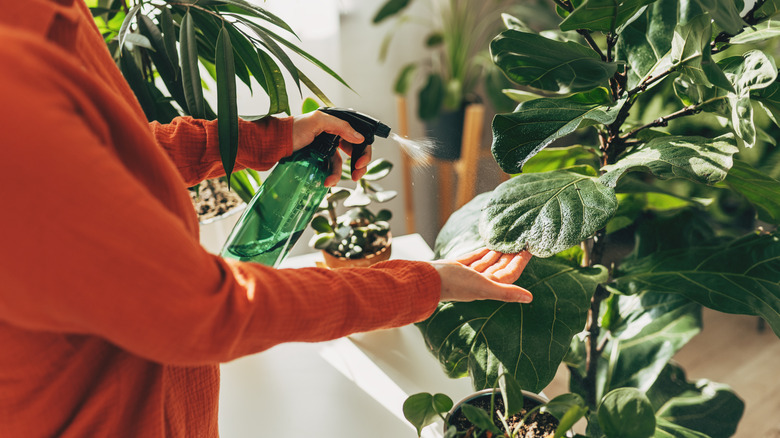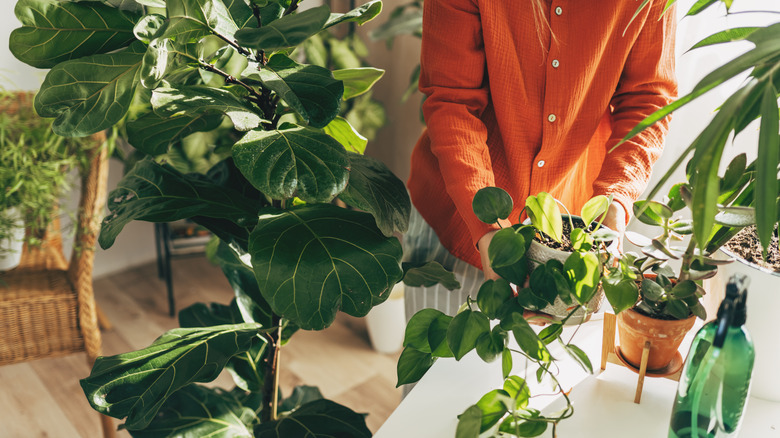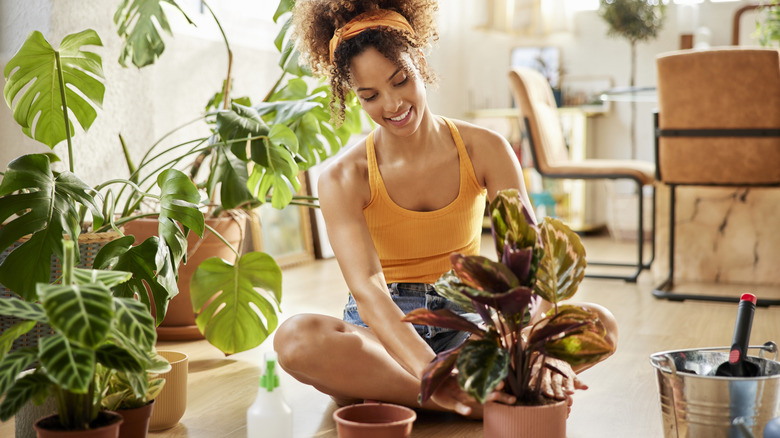Keep Houseplants Thriving With A Hydrogen Peroxide Solution You Can DIY
Plant lovers know the feeling all too well. One day, you have a thriving, bright green beauty sitting atop your countertop, and the next, it's showing signs of decay or disease. As frustrating as that can be, there is a simple DIY solution you can mix at home that may help save your dying plant. And all you need to make it is water and hydrogen peroxide. This mixture can be applied to both the soil and foliage of houseplants when you notice signs of distress, delivering both aid and oxygen to the parts that need it the most.
While most people associate hydrogen peroxide with something you keep stocked in the medicine cabinet for cuts or cleaning, it's actually helpful to plants and even safe for them when used at the right concentration. That's because it breaks down into just oxygen and water. Hydrogen peroxide is made up of the same elements as water (H₂O) but with an extra oxygen atom (H₂O₂), and it rapidly decomposes in soil. That extra oxygen atom allows hydrogen peroxide, when applied in a less diluted mixture directly to the soil, to help plant roots absorb more nutrients. It can also replenish oxygen in the soil while preventing and controlling bacteria and fungi growth, which are common causes of root rot. Hydrogen peroxide, when sprayed on foliage in a diluted form, can also help control pests such as fungus gnats and aphids, giving houseplants an added layer of protection.
Applying hydrogen peroxide to your houseplants
If your houseplant is starting to look like it's on its last leg, it could be due to root rot, pests, underwatering, or other common issues. To tackle insects and pests that may have made a home in your plants, mix 1 teaspoon of 3% hydrogen peroxide with 1 cup of water in a spray bottle and mist the leaves. This can help protect against pests like fungus gnats, which feed on plant roots, and aphids, which suck the sap your greenery needs to grow.
That's above the soil, but hydrogen peroxide works its real magic beneath the surface. If bacteria or fungi are attacking your plant's roots, or if the soil's oxygen levels are out of balance due to overwatering, you can address these things by mixing a one-to-one solution of 3% hydrogen peroxide and water and pouring it directly into the soil (never on the leaves, as it can burn them). The hydrogen peroxide mixture helps kill off the harmful stuff and restore healthy oxygen levels, according to Jagmeet Singh, owner of Daisy Creek Farms in California. This works because hydrogen peroxide attacks fungus and bacteria much like it does when applied to a cut on the skin. It also improves soil aeration, creating air passages that allow more oxygen to reach the roots.
Other ways hydrogen peroxide can be used for plant care
The benefits of using hydrogen peroxide in gardening go beyond spraying leaves and watering the soil. A DIY solution made with 3% hydrogen peroxide and water can also sanitize your garden plant containers between uses, preventing the spread of plant pathogens. To clean a container, simply pour the solution inside and wipe it down.
You can also spray the growing medium with a one-to-one mix, which helps prevent early-stage fungus or bacterial growth in the soil, giving your plant a healthier start. As mentioned earlier, watering the soil with this solution can also promote strong root growth by improving soil aeration. As if that weren't enough, you can even use hydrogen peroxide to germinate seeds before planting by briefly soaking them in a cup. This quick cleansing step can help reduce the risk of root rot and disease. While no method is guaranteed to work, and you may need to mist your plant babies a few times with your DIY mix to fully eliminate pests, it's still a cleaner, less harmful way to care for your indoor (and outdoor) plants.


